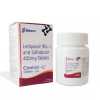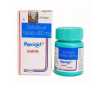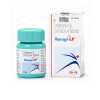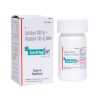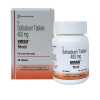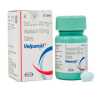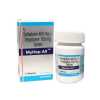- 05.09.2018
Sofosbuvir (Sofosbuvir)
Content
Latin substance name Sofosbuvir
Pharmacological group of substance Sofosbuvir
Characteristics of the substance Sofosbuvir
Pharmacology
Use of the substance Sofosbuvir
Contraindications
Restrictions on the use of
Use during pregnancy and lactation
Side effects of the substance Sofosbuvir
Interaction
Overdose
Route of administration
Precautions for substance Sofosbuvir
Interactions with other active ingredients
Trade names
Latin substance name Sofosbuvir
Sofosbuvirum (genus. Sofosbuviri)
Chemical name
propan-2-yl (2S) [[[(2R, 3R, 4R, 5R) -5- (2,4-dioxopyrimidin-1-yl) -4-fluoro-3-hydroxy-4-methyloxolan-2-yl ] methoxy-phenoxyphosphoryl] amino] propanoate
Gross formula
C22H29FN3O9P
Pharmacological group of substance Sofosbuvir
Antiviral drugs
Nosological classification (ICD-10)
B18.2 Chronic viral hepatitis C
Characteristics of the substance Sofosbuvir
Nucleotide pangenotypic inhibitor of the RNA-dependent NS5B RNA polymerase of the hepatitis C virus
RxList.com
Molecular weight is 529.45. A white or not quite white crystalline solid with a solubility of ≥2 mg / ml in the range of pH 2-7.7 at 37 ° C, slightly soluble in water.
Pharmacology
Pharmacological action - antiviral.
Pharmacodynamics
Mechanism of action.
Sofosbuvir is a pangenotypic inhibitor of the RNA-dependent NS5B RNA polymerase of the hepatitis C virus (HCV) required for viral replication. Sofosbuvir is a nucleotide prodrug that undergoes intracellular metabolism to form a pharmacologically active uridine triphosphate analogue (GS-461203). Using NS5B polymerase, GS-461203 can be inserted into the HCV RNA chain under construction and act as a chain terminator. This active metabolite of sofosbuvir (GS-461203) suppressed the polymerase activity of HCV genotypes 1b, 2a, 3a, and 4a at concentrations that caused 50% inhibition (IC50) in the range of 0.7 to 2.6 μmol. The active metabolite of sofosbuvir (GS-461203) does not inhibit human DNA and RNA polymerase and human mitochondrial RNA polymerase.
Antiviral activity
In studies using HCV replicons, the effective concentration (EC50) values of sofosbuvir versus full-length replicons of genotypes 1a, 1b, 2a, 3a, and HCV were 0.04; 0.11; 0.05; 0.05 and 0.04 μmol, respectively, and the EC50 values of sofosbuvir against chimeric replicons of genotype 1b, carrying the NS5B sequences from genotypes 2b, 5a, or 6a, were 0.014–0.015 μmol. The mean EC50 ± standard deviation (SD) of sofosbuvir for chimeric replicons carrying NS5B sequences from clinical isolates was (0.068 ± 0.024) μmol for genotype 1a, (0.11 ± 0.029) μmol for genotype 1b, (0.035 ± 0.018) μmol for genotype 2 and (0.085 ± 0.034) μmol for genotype 3a. The in vitro antiviral activity of sofosbuvir with respect to less frequently encountered genotypes 4, 5 and 6 was similar to that with respect to genotypes 1, 2 and 3.
There was no significant change in the antiviral activity of sofosbuvir in the presence of 40% human serum.
Resistance
In cell culture. Reduced sensitivity to sofosbuvir was associated with the primary mutation S282T in NS5B of all studied HCV replicon genotypes (1b, 2a, 2b, 3a, 4a, 5a, and 6a).
Site-directed mutagenesis confirmed that the S282T mutation in replicons of 8 genotypes was responsible for a decrease of 2–18 times in sensitivity to sofosbuvir and a decrease in the replication ability of the virus by 89–99% compared with the corresponding wild-type virus. Recombinant NS5B polymerase from genotypes 1b, 2a, 3a, and 4a, expressing the S282T substitution, demonstrated reduced sensitivity to the active metabolite of sofosbuvir (GS-461203) compared with similar wild-type polymerases.
In clinical studies. Of the 991 patients who received sofosbuvir in clinical studies, 226 patients were selected for resistance analysis due to virological failure or early discontinuation of the studied drug and HCV RNA concentration> 1000 IU / ml. Sequence changes in NS5B compared with baseline were evaluated in 225 of 226 patients, with deep sequencing data (analysis threshold 1%) obtained from 221 of these patients. The mutation S282T, which is responsible for resistance to sofosbuvir, was not detected in either of these patients by either the deep sequencing method or population sequencing. The S282T mutation in NS5B was detected in a single patient who received sofosbuvir monotherapy. The S282T mutation returned to wild type over the next 8 weeks and 12 weeks after cessation of therapy was not determined by deep sequencing.
Two mutations of NS5B, L159F and V321A, were determined in samples of several patients with HCV genotype 3 during the relapse period after discontinuation of therapy in clinical studies. Changes in phenotypic sensitivity to sofosbuvir or ribavirin in patient isolates

